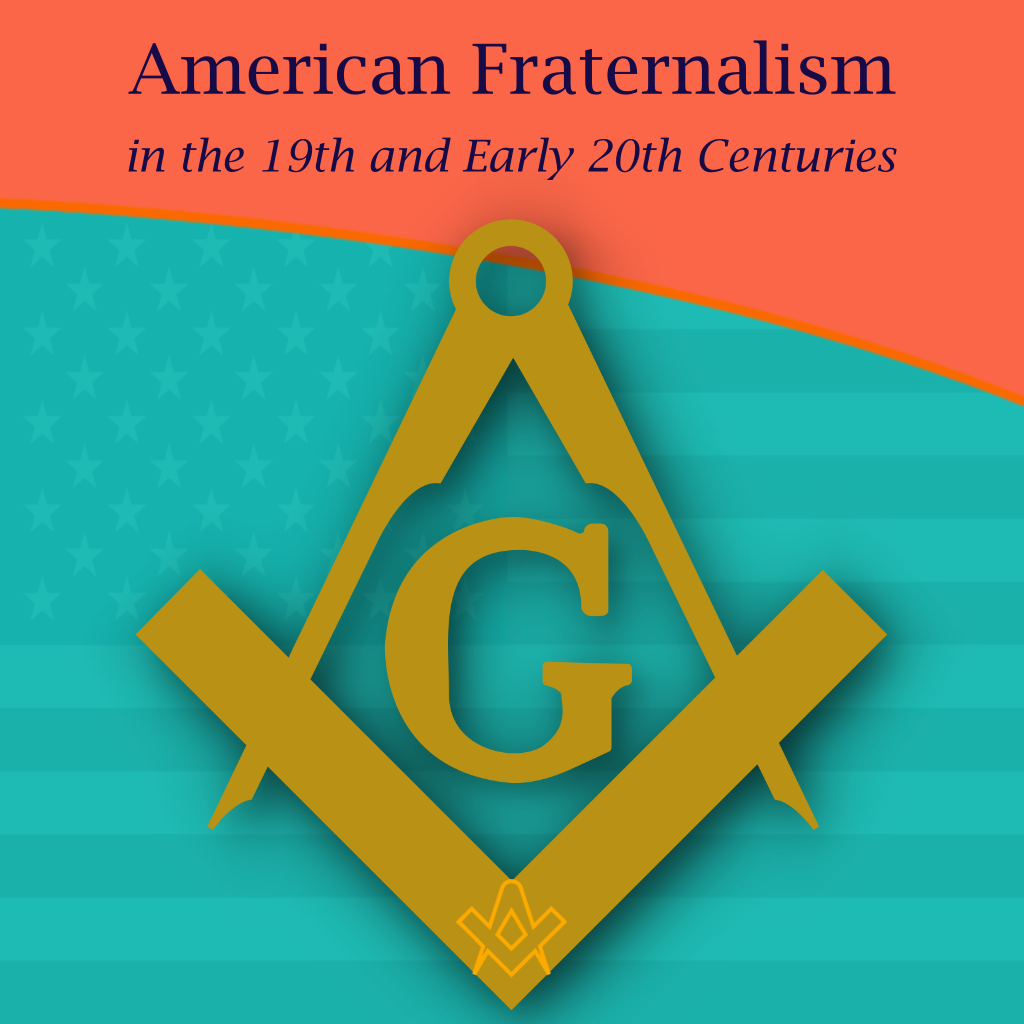The late 19th and early 20th centuries in the United States has been called the “Golden Age of Fraternalism.” How did this come about and why was the idea of joining a fraternal organization so popular? We will explore this question and examine the regalia used by many fraternal organizations in this period.
American Fraternalism in the 19th and Early 20th Centuries
Bill Kreuger
This article is based on a presentation that was given at the November 2012 Midwest Open Air Museums MOMCC Fall Conference that was held in Cedar Rapids, lowa. Reproduced here by kind permission of the author and Midwest Open Air Museums Magazine (link PDF file) in which it first appeared in Vol. 33 No. 2. Summer, 2022.
All photos courtesy of the Iowa Masonic Library and Museums.
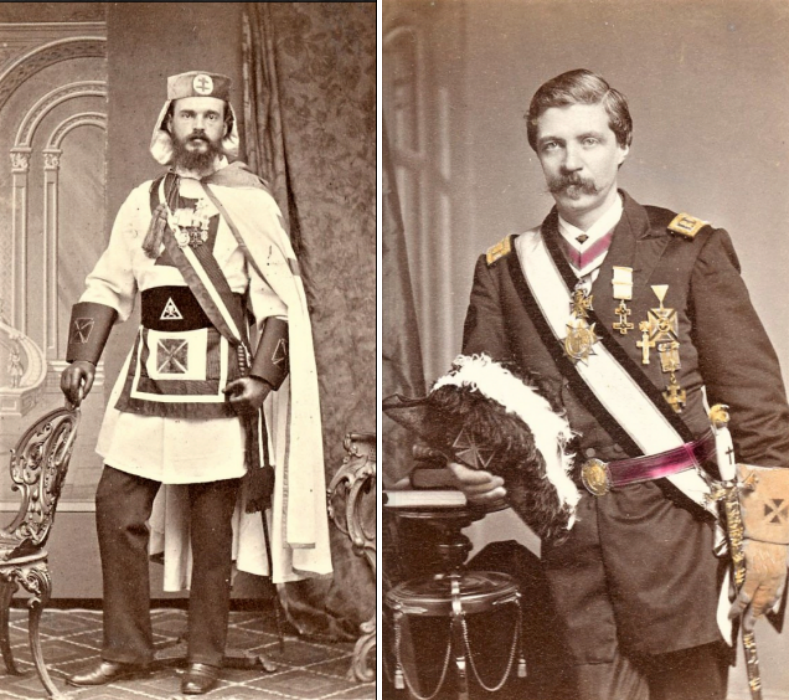
Henry Robertson of Ontario, Canada, shown in both photos, wearing two different versions of a Knights Templar uniform and regalia.
IMAGE LINKED: Iowa Masonic Library and Museums Attribution 4.0 International (CC BY 4.0)
A modern definition of a fraternal society is a “club or other sociation, usually of men, having a limited membership and devoted to professional, religious, charitable, social activities. [1]
By the time of the American Revolution, fraternalism was nothing new. One of the oldest fraternal organizations, the Freemasons, started in 1717 as an outgrowth of the Stonemason’s guilds in Scotland and England.
It was brought to America by early colonists and by British military lodges in about the 1730s to places such as Boston and Philadelphia.
The Odd Fellows began in the United States in the early 1800s and the Order of Redmen was founded in the United States in 1834. The Order of Redmen, the first “American-made” fraternal organization, supposedly goes back to the Sons of Liberty, which was a secret society during the Revolutionary War. [2]
Societies such as the Freemasons were very exclusive in the pre-Revolutionary period, in that they limited membership to men of similar social and economic status.
Joining the lodge was an expensive and complex proposition. This was purposely done to ensure that men of a “benevolent mind entered the lodge.” [3]
Some fraternal societies such as the Society of the Cincinnati were, and still are hereditary. This organization limits membership to qualified male descendants of commissioned officers in the Continental Army or Navy, or of officers of the French royal forces who served in America during the Revolutionary War. [4]
Masonic and other fraternal groups may have grown out of the popularity of English clubs in the 17th and early 18th centuries.
Masonic activities often drew on the practices of other clubs. Both groups usually met in private rooms of taverns, denying entrance except to members. Newcomers were admitted only by general consent.
Both groups closed with members clubbing together to pay the bill. [5]
In the early 1830s, Frenchmen Alexis de Tocqueville and Gustave de Beaumont traveled to America to study the American prison system.
They traveled by steamboat, stagecoach, horseback, and canoe from Michigan to Louisiana and places in between.
During his travels, de Tocqueville observed American life and culture and wrote Democracy in America in 1835.
Among his observations was the fact that Americans were joiners and formed all manner of associations. Americans of all ages, all conditions, and all dispositions constantly form associations.
They have not only commercial and manufacturing companies, in which all take part, but associations of a thousand other kinds, religious, moral, serious, futile, general, or restricted, enormous, or diminutive.
The Americans make associations to give entertainments, to found seminaries, to build inns, to construct churches, to diffuse books, to send missionaries to the antipodes.
Whenever at the head of some new undertaking you see the government in France, or a man of rank in England, in the United States you will be sure to find an association. [6]
At the same time that de Tocqueville and Beaumont were visiting, the United States and Freemasonry were in the throes of an Anti-Masonic period starting in 1826, called the “Morgan Affair.”
The anti-Masonic uprising began when William Morgan, supposedly a Mason from upstate New York, published materials revealing the secrets of Freemasonry.
During this period, the lessons and passwords of the Masonic fraternity were supposed to be passed from mouth to ear within a lodge.
Morgan is said to have been kidnapped by Masons and killed. No proof of this has ever been found.
However, the event gave rise to a politically motivated Anti-Masonic party in America and led to the shuttering of Masonic lodges in many places and a decrease in membership and activity in fraternal organizations.
By the early 1850s, the remnants of the Morgan Affair and anti-Masonic sentiment had largely disappeared and fraternal organizations slowly re-organized and re-emerged.
The Great Fraternal Movement
According to historian, Harriet McBride, what has been called “The Great Fraternal Movement” in America took place after the Civil War, beginning in 1866.
This specific year saw the development of two important fraternal organizations in the United States: the Grand Army of the Republic, and the Knights of Pythias.
Both were popular due to their use of regalia and uniforms, social amenities, structure, and stability. [7]

Masonic apron used in a Royal Arch Masonic chapter.
IMAGE LINKED: Iowa Masonic Library and Museums Attribution 4.0 International (CC BY 4.0)
Masonic apron used in a Royal Arch Masonic chapter. The Masonic apron is a reminder of the aprons used by Medieval operative masons – so is a link with the past.
The flap indicates that there was a pocket in the apron, where operative masons would keep their working tools.
This would have been a personal apron used by a member of a Royal Arch Masonic chapter in the early to mid-19th century and is decorated with printed symbols of that body.
Freemasonry tells the story of the construction of Solomon’s Temple, and in the center of the apron you can see the front porch of the Temple, the altar, and lights surrounding the altar.
Surrounding the exterior of the porch are various symbols that are important to this Masonic degree, including the words on the flap “Holiness to the Lord.”
This is a leather apron, decorated with cotton fringe.
Fraternalism grew and became popular in the late 19th and early 20th centuries for a variety of reasons.
Fraternalism provided a conviviality and a social and entertainment outlet. Masonic lodges, as well as other fraternal groups, became like amateur thespians.
The rituals were sometimes performed in full costume and regalia, and theatrical backdrops and staging were used for the degree work.
The degree activities presented in this fashion almost became a series of miniature “passion plays.”
The interior of fraternal lodge buildings often began to look like theatres, with rows of chairs, balconies, and various forms of lighting. Fraternalism provided a sense of community betterment.
For example, many of the early movers and shakers in Cedar Rapids, lowa, participated in fraternal organizations, as well as various community betterment projects including the fire department, the Cedar River Bridge company, and Greene’s Opera House. [8]
These societies provided a means to help those who were unable to help themselves. Many fraternal societies have a mandate to care for widows and orphans of members.
For instance, the Pythian Home in Decatur, Illinois was established to care for aged members, and orphans of Pythian members. [9]
Some fraternal organizations provided benefits such as life insurance to members. These were known as Fraternal Benefit Societies, and many exist today as life insurance companies.
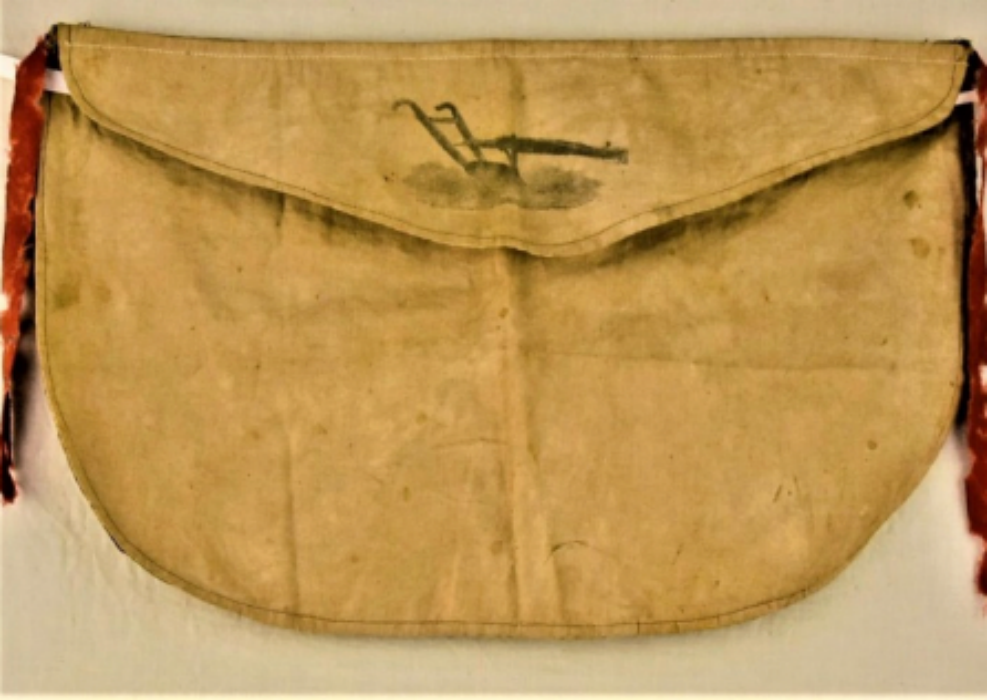
Apron of the Order of Patrons of Husbandry, late 19th century.
IMAGE LINKED: Iowa Masonic Library and Museums Attribution 4.0 International (CC BY 4.0)
Apron of the Order of Patrons of Husbandry, late 19th century.
The Patrons of Husbandry was founded by Oliver Kelley and six others in Minnesota as a fraternal society for farmers after the American Civil War.
It was felt that farmers did not have a voice and that a fraternal organization might help to unify and organize them.
The meeting places of the Order were called “Granges,” and this name has been used as an alternative name for the Order. The Order of Patrons of Husbandry continues to exist to the present day.
Fraternal organizations also gave immigrants a ready-made source of social and community networks which led to social integration within the community.
For instance, Czech fraternal societies like ZCBJ and CSPS in Cedar Rapids and lowa City became important community centers for these immigrant groups.
These organizations had fancy regalia like uniforms. In cities where the Knights Templar held their triennial meetings or conclaves, large parades were held with Templars in full regalia.
African Americans and others of color were often discriminated against in joining Caucasian fraternal groups so African Americans formed their own organizations.
Perhaps the most well-known African American organization is Prince Hall Masonry.
Named after a freed man, Prince Hall and fourteen other free black men were initiated into Lodge No.441, Irish Constitution, attached to the 38″ Regiment of Foot of the British Army garrisoned at Castle William in Boston Harbor on March 6, 1775. [10]
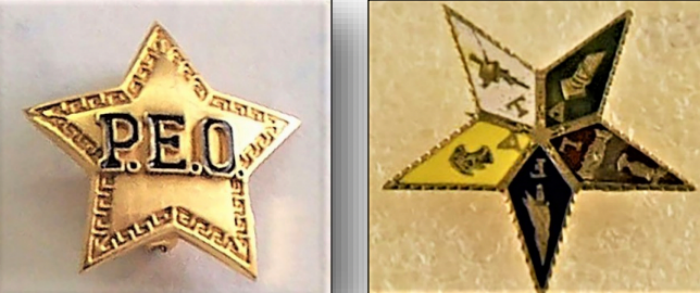
Left – Five-pointed star emblem of the P.E.O. Sisterhood, a women’s social and educational fraternal organization founded at Iowa Wesleyan College in 1870. It still exists to the present day.
Right – An Order of the Eastern Star pin that was presented to Mrs. Sarah Sherman of Monticello, Iowa by Rob Morris. Morris wrote the first ritual of the Order of the Eastern Star in the mid-1850s while he was living and teaching in Kentucky. Image: Iowa Masonic Library and Museums
Women were usually also not allowed to join men’s fraternal societies. They often formed their own organizations such as P.E.0. (Philanthropic Educational Organization), or were “adopted” by men’s fraternal organizations, i.e., Order of the Eastern Star in Masonry, or the Heroines of Jericho.
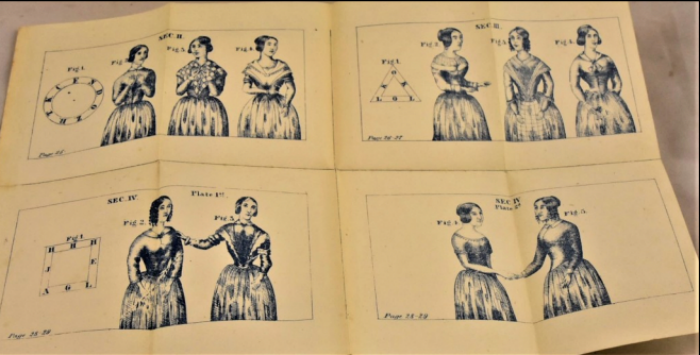
This chart shows the hand movements for a woman’s fraternal degree entitled The Holy Virgin.
It is from a book in the collection of the Iowa Masonic Library entitled The Ladies Masonry: The Holy Virgin and the Heroine of Jericho.
The Heroine of Jericho was a side degree of the Royal Arch degrees in Masonry, which allowed female relatives of Masons to join a fraternal organization.
The book dates to 1851 and was published in Louisville, Kentucky. Image: Iowa Masonic Library and Museums
By the late 1890s, the membership of secret fraternal orders in the United States was at 5,400,000.
“Taking the adult male population of the nation at that time to be nineteen million and allowing that some men belonged to more than one order, it can be seen that, broadly speaking every fifth, or possibly every eighth, man you met was identified with some fraternal organization…” [11]
The growth of fraternal organizations led to the development of vendors that provided the clothing, regalia, and devices worn and used by fraternal groups.
Some of them include the DeMoulin Brothers & Co. of Greenville, Illinois, M.C. Lilley and Co. of Columbus, Ohio, the C .E. Ward Co. of New London, Ohio, and Whitehead & Hoag Co, in New Jersey.
The DeMoulin Brothers created an apparatus called the “lodge goat,” that was used by some fraternal organizations as a hazing device when initiating new candidates. [12]
As noted above, by the turn of the 20th Century more than five million members in the United States were involved in one or several fraternal organizations.
Unfortunately, this is not something one sees being interpreted today at open air living history museums. There are, however, at least two exceptions.
The first is the Oliver Kelley Farm in Elk River, Minnesota. Kelley was one of the founders and leaders of a fraternal organization known as the Order of the Patrons of Husbandry, also known as the Grange.
This organization provided a means for farmers to organize and share information.
The Oliver Kelley Farm teaches about the Grange and the role that Oliver Kelley and his family played in its development.

A group photograph of members of Masonic Lodge No.285, Plumb Lodge, located in Siam, Iowa.
IMAGE LINKED: Iowa Masonic Library and Museums Attribution 4.0 International (CC BY 4.0)
A group photograph of members of Masonic Lodge No.285, Plumb Lodge, located in Siam, Iowa.
Siam is in the southwestern section of the state, near the Missouri border. Members are dressed in their Masonic regalia, including aprons, sashes, and implements of their respective offices in the Lodge.
The Deacons of the Lodge carry what look like spears (termed Rods); the Tyler in left front of the photograph carries a sword.
The Worshipful Master (head of the Lodge) is seated in the right front, wearing a hat and a square medallion that hangs from his neck.
Second is an annual event called “The Day the War Stopped”, in St. Francisville, Louisiana, in mid-June.
It commemorates the day in June 1863 when Union sailors under a flag of truce came searching for fellow Masons in St. Francisville to bury their commanding officer with Masonic honors.
Confederate Masons joined with Union Masons to bury Lt. Commander John E. Hart of the U.S. Navy in a local cemetery.
Hart was commanding officer of the U.S.S. Albatross, a Civil War gunboat that was operating on the Mississippi River. During the special event, a small Masonic funeral is held, as well as various demonstrations by Civil War re-enactors.
The event this year [was] held on June 11, 2022. [13]
FRATERNAL ORGANIZATION BADGES
– from the collections in the Iowa Masonic Museums
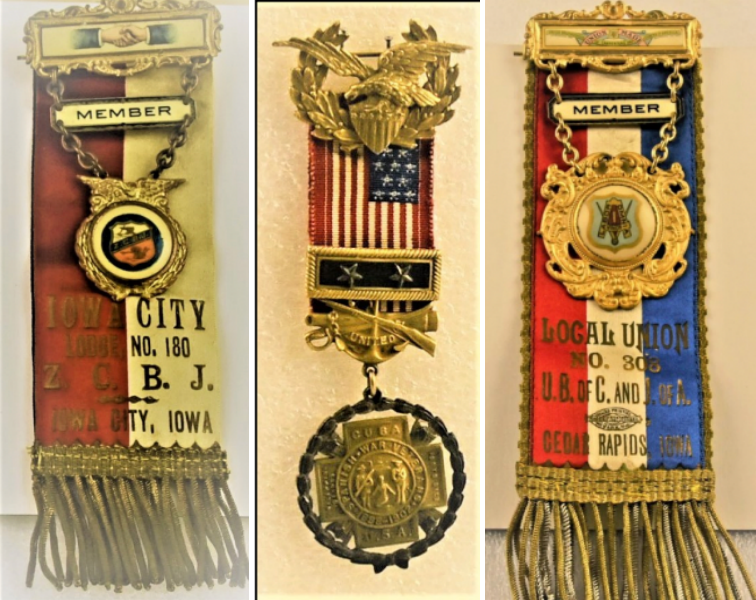
Left: Fraternal member’s badge for the Zapadni Cesko Batrska Judnota Czech Fraternal society. The name translates to Western Bohemia Fraternal Association, which is a fraternal benefit society that has its roots in the Czech immigrant communities throughout the United States.
The name was changed to the Western Fraternal Life Association in 1971. The organization continues to the present day and recently merged with the National Mutual Benefit life insurance society. The ZCBJ/WFLA was headquartered in Cedar Rapids, Iowa for more than 100 years and is now located in Madison, Wisconsin. This is a badge for Lodge no. 180 in Iowa City, Iowa, late 19th century.
Centre: Department head badge for the United Spanish War Veterans.
This veteran’s fraternal organization was founded in 1904 and was composed of veterans from the Spanish-American War, Philippine-American War, and the China Relief Expedition (Boxer Rebellion).
This fraternal society continued until 1992 when the last Spanish American War veteran died.
Right: Badge for the United Brotherhood of Carpenters and Joiners of America, Local Union No.308 of Cedar Rapids, Iowa in the late 19th to early 20th century.
This is a comparison to show that many unions used badges like those used in fraternal organizations and to show a kinship between fraternal groups and union organizations.
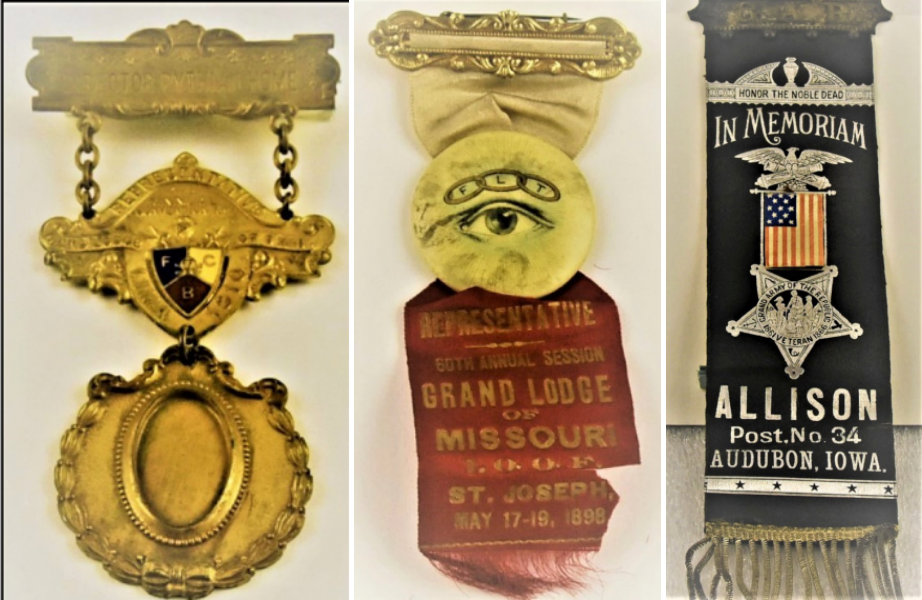
Left: Convention badge of the administrator of the Pythian Home in Ohio, for the 1910 Knights of Pythias Convention held in Lima, Ohio.
The top of the badge would be pinned to a uniform or coat, the middle section carries the convention information and Knights of Pythias shield, and the bottom section was used to hold a photograph of the individual.
The photograph has been lost over time. The shield includes the letters “F.C.B.,” which stand for “Friendship, Charity, and Benevolence.” These ideals represent the important attributes of the Knights of Pythias. The KOP began in 1864 and is still active today.
Centre: Odd Fellows badge that was provided to an official representative of the Grand Lodge of Missouri at their annual meeting held In St. Joseph, Missouri in May 1898.
On the button, you can see the three links with the letters “F,” “L,” and “T” above the all-seeing eye.
The letters stand for the three important attributes of Odd Fellowship: Friendship, Love, and Truth. Sometimes referred to as “the poor man’s Masonry,” Odd Fellows used regalia similar to that of the Freemasons.
Right: Grand Army of the Republic “Mourning” badge from Allison Post No.34 in Audubon, Iowa, late 19th century.
The badge carries the symbol of the G.A.R., with the inscribed words, “Honor the Noble Dead,” and “In Memoriam.”
This badge would have been worn by members of the Post as a tribute when a member had died.
The Grand Army of the Republic was started in 1866 in Springfield, Illinois as a veteran’s fraternal organization. It was composed of veterans of the Union Army, Navy, and Marine Corps who had served in the American Civil War.
Posts were established in nearly every state and each post assigned a sequential number based upon its admission into the state’s GAR Department.
About the Author

Bill Kreuger has a B.A. in History from Millikin University, an M.S. in Library Science, and an M.A. in Historical Administration, both from Eastern Illinois University.
He has worked in museums and historical societies in various parts of the Midwest such as Indiana, Wisconsin, Kentucky, and Iowa., and has served in various positions, including collections, historic site administrator, curator of education, and director.
He recently retired after 25 years as Assistant Librarian and Curator of the Iowa Masonic Library and Museums in Cedar Rapids, a position he held since 1997.
The lowa Masonic Library and Museums in Cedar Rapids is one of the largest Masonic libraries in the United States and has information about Freemasonry and many other fraternal organizations. It also displays regalia used by Freemasons and other fraternal organizations in the museum exhibits.
The library and museums are open by appointment, Monday through Friday 8 a.m. to noon and 1 to 5 p.m. Guided tours of the museum collections are available by appointment at 10 a.m. and 2 p.m.
Please call 319-365-1438 or email: Librarian@gl-iowa.org
Footnotes
Reference
1. Collins English Dictionary 2005. Accessed February 28, 2022
https://www.collinsdictionary.com/us/dictionary/english/fraternal-society
2. Alvin J. Schmidt, Fraternal Organizations (West Port, Conn: Greenwood Press, 1980), 287.
3. Steve C. Bullock, Revolutionary Brotherhood: Freemasonry and the Transition of the American Social Order, 1730-1840 (Chapel Hill, NC: Univ. of North Carolina Press, 1996), 65-66.
4. The Society of the Cincinnati, Membership Overview, 2022. Accessed February 28, 2022. https://www.societyofthecincinnati.org/membership-overview.
5. Bullock, Revolutionary Brotherhood, 29. Summer 2022.
6. Alexis de Tocqueville, Democracy in America Volume 2 (New York: Alfred A. Knopf, 1945), 106.
7. Harriet W. McBride “The Golden Age of Fraternalism: 1870-1910, in Heredom: the Transactions of the Scottish Rite Research Society, no. 13, (2005): 126.
8. Roster The Steam Fire Engine Company, No.1,” Vertical file collection, lowa Masonic Library. History of Linn County, Iowa by Luther A. Brewer, and Barthinius L. Wick (Chicago: The Pioneer Publishing Co., 1911), 421.
9. Pythian Home postcard, accessed March 1, 2022, http://flickr.com/photos/sallyneely/2879240659.
10. “The First Worshipful Master African Lodge No.459, Boston, Massachusetts,” Most Worshipful Union Grand Lodge of Florida, Sesquicentennial Historical Journal: 150 Years of Masonic Excellence, 1870-2020 [Jacksonville, Fla.]: M.W. Union Grand Lodge of Florida, 2020.
11. W.S. Harwood “Secret Societies in America,” The North American Review, no. 164, (May 1897): 617.
12. John Goldsmith Three Frenchmen and a Goat: DeMoulin Brothers Story (n.p.: Tri-State Litho, 2004): 19.
13. The Day the War Stopped, accessed March 1, 2022, http://www.stfrancisvillefestivals.com/features/day-the-war-stopped
Recent Articles: history series
 Narratives of History |
 A Very Royal Sesquicentenary |
 Unveiling the Enigma: Discover the Royal Society's Legacy and its Impact on Science. Delve into the fascinating history of the Royal Society, the prestigious UK academy shaping scientific progress since 1660. Explore its pivotal role in advancing knowledge, fostering collaboration, and unlocking the secrets of the universe. Prepare to be amazed! |
 Knights Templar in Freemasonry Uncover the Mysteries of the Knights Templar in Freemasonry! Delve into the intriguing world where chivalry and symbolism intertwine. Discover the captivating rituals and ancient secrets behind the Knights Templar Masonic Orders. Explore the historical connection and delve into the enigmatic narratives that continue to fascinate enthusiasts today. Unveil the hidden truths now! |
 The Royal Arch stands as the rainbow of promise in the Ritual; it stands as the promise of the resurrection; of that which was lost and that it shall be recovered. The question arises as to whether the Master's Word was originally communicated in the Third Degree? On this point there is some diversity of opinion. Originally published in 1915, this insight into the Fourth Degree – the Holy Royal Arch – is as relevant today as it was over 100 years ago. |
 Unveiling the Mysteries of Druidism: Discover the Intriguing Connection with Freemasonry. Explore the ancient spiritual practice of Druidism and its fascinating ties to the enigmatic world of Freemasonry. Delve into the shared symbolism and rituals that have captivated minds for centuries. Unlock the secrets of these intertwined traditions today! |
 Uncover the legacy of freestone masons and their pivotal role in crafting medieval cathedrals. Discover the artistry behind their techniques, the hierarchy within their craft, and the enduring impact of their intricate carvings. A deep dive into the world of these master craftsmen awaits you! |
 Unearth the intriguing journey from Vincha Culture to Freemasonry. Discover how ancient building methods intertwine with modern Masonic philosophies. This exploration will shed light on the fascinating link between the Serbian term "shestarenye" and the symbolic significance of the compass in Freemasonry. |
 Freemasonry and the Illuminati Unravel the enigmatic world of Freemasonry and the Illuminati in our latest exposé. Dive into centuries-old mysteries, debunk conspiracy theories, and discover the truth behind these elusive societies. Are they puppet masters or mere myths? Join us as we dissect history and fact from fiction. |
 The Île des Templiers, or “Island of the Templars” lies within a leafy park in Paris. The execution site of Jacques du Molay, the last Grand Master of the Knights’ Templar bears a plaque with the epitaph ‘A cet endroit / Jacques de Molay / Dernier grand maître / de l'ordre du temple / a été brûlé le 18 Mars 1314’ (‘In this location / Jacques de Molay / Last grand master / of the order of the temple / was burned on 18 March 1314’) |
 Operative Progressions to Speculative Masonry Both Operative and Speculative Masonry are an important part of the modern fraternity of Freemasonry, which combines elements of both traditions. Today, Freemasonry is a fraternity that is open to men of good character, who are interested in personal development and in making a positive contribution to their communities. |
 General Regulations of a Free Mason, 1723 General Regulations of a Free Mason as contained in Anderson's Constitutions of the Freemasons, published 1723. the Regulations are of great historical interest. Compiled by George Payne, the second Grand Master of the Premier Grand Lodge of England, they were printed in 1722/3, thus published just over five years after the formation of the Grand Lodge 1717. |
 The Genesis of the 1723 Book of Constitutions 2023, marks the three hundredth anniversary of the publication of the first printed Book of Constitutions of the Grand Lodge formally established in London two years previously. This is an anniversary whose significance extends beyond freemasonry. A paper by Andrew Prescott |
 The Ritual of the Operative Free Masons - P3 Existing Operative Free Masons. The ritual I am about to refer, is that of "The Worshipful Society of Free Masons, Rough Masons, Wallers, Slaters, Paviors, Plaisterers, and Bricklayers." By Thomas Carr, M.D., P. M. Honorary Member of the Guild of Operative Free Masons |
 Liberté chérie was a Masonic Lodge founded in 1943 by Belgian Resistance fighters and other political prisoners at Esterwegen concentration camp. It was one of the few lodges of Freemasons founded within a Nazi concentration camp during the Second World War. |
 The Ritual of the Operative Free Masons - P2 If anyone doubts the fact that the formation of Speculative Free Masonry was due to and based upon Operative Free Masonry, it is quite easy to convince him of his error if he will only study the first Book of Constitutions. By Thomas Carr, M.D., P. M. Honorary Member of the Guild of Operative Free Masons |
 In 1881, Freemasonry rose from the ashes of a fire in the mining town of Kokomo, Summit County, Colorado. Corinthian Lodge No. 42, along with Kokomo, no longer exists but it holds the record of having been – at an elevation of 10,618 feet – the highest Masonic Lodge in the USA. |
 The Huguenots and Early Modern Freemasonry The Huguenots influence in the development of early modern Freemasonry at the time of the formation of the Grand Lodge in London around 1717 / 1723. |
 November is a month of reflection – perhaps due to the fact that we are getting close to the years' end – but also because Remembrance / Armistice Day (11 November) is a significant date in most countries' diaries. |
 Speculative Freemasonry, as practise by Grand Lodge of England, was officially born just over three hundred years ago, is today an international organisation, counting over six million members. It has been subjected to persecution, suppression, and abolition throughout its history. In its infancy, only a couple of decades after its official birth, it had already become a target. |
 The Ritual of the Operative Free Masons - P1 The original paper was written, first, to prove that Speculative Free Masonry was derived from Operative Free Masonry; second, to give some account of the Operative Free Masons, of their Ritual, and of their customs. By Thomas Carr, M.D., P. M. Honorary Member of the Guild of Operative Free Masons |
 American Fraternalism in the 19th and Early 20th Centuries The late 19th and early 20th centuries in the United States has been called the "Golden Age of Fraternalism." How did this come about and why was the idea of joining a fraternal organization so popular? We will explore this question and examine the regalia used by many fraternal organizations in this period. |
 Societas Draconistarum, meaning "Society of the Dragonists"– was a chivalric Order for selected nobility, founded in 1408 by Sigismund von Luxembourg, who through marriage became the King of Hungary (1387–1437) and later Holy Roman Emperor. The Order was fashioned after the military orders of the Crusades, requiring its initiates to defend the cross and fight the enemies of Christianity, in particular the Ottoman Empire. |
 The Perjured Free Mason Detected Was Samuel Prichard a perjured individual, or simply a misguided Freemason? Prichard's book "Free Masonry Dissected" published in 1730, is now used by many Masonic historians as a source of reference with regards to the introduction of the third degree into the Craft. But at the time it was published in 1730, it was not so well received by members of the Grand Lodge of England. |
 17th century and the Holy Royal Arch This article focuses on a period of transition between a point in time when we can safely and historically identify the first formation of what could be called as the ‘Royal Arch’ and the historical events that have preceded it. |
 Most Freemasons have heard the terms 'Operative' and 'Speculative' Masons, and this article helps to understand the difference: |
 Roberts' Constitutions of Freemasonry 1722 Published a year before Anderson's Constitutions, The Old Constitutions Belonging to the Ancient and Honourable SOCIETY OF Free and Accepted MASONS. Originally printed in London England; Sold by J. Roberts, in Warwick-Lane, MDCCXXII.(1722) |
 From 'Songs of religion and life', 1876 by John Stuart Blackie (1809-1895) |
 On the Antiquity of Masonic Symbolism Is the Symbolism of Masonry an inheritance derived from the old Masons who flourished before the era of the Grand Lodges (1717); or has it been borrowed from the Rosicrucians or others, after 1717? |
 Mason's Marks – from Egypt to Europe? Mason's marks have been a source of intrigue, not only to Freemasons but to historians and archaeologists. The use of simple pictograms have been employed for millennia by artisans to identify their work. But where did they originate and why? |
 The White House Foundation Stones Further to the articles in our series on the history of the stone masons, we have a rather intriguing addition. During the 1950's renovation of the White House, President Truman retrieved more than 100 stone blocks with stonemasons marks. |
 What the Goose and Gridiron Tavern is in the ancient annals of London Freemasonry, The Green Dragon Tavern is to the memories of the Free-mason, of Boston and New England. |
 Auschwitz concentration camp: video photo article taken in 2013 |
 There are two things of importance happening this day - 27 January |
 Two approaches regarding the understanding of Freemasonry |
 Masonic Research in England c1930 An article which appeared in an American Masonic magazine, c1930 and which was reproduced in England, provoking a little controversy. |
 Masonic bookplates the ‘Brethren’s spiritual coats of arms and marks’ |
 The Unlawful Societies Act of 1799 Rebellious Freemasons and the 21st century |
 In 1912, Sarah Dowd of Dromore, Ireland, found a Masonic jewel dated 1517 - a date two hundred years before the establishment of Grand Lodge... |
 Freemasonry and Fascist Regime Interesting speech by the famous historian Prof. Aldo A. Mola, who links the fascist regime with the Masonic Associations. |
 Was famous Russian poet Alexander Pushkin a Freemason? And if so, was he a member of the lodge ‘for which all the lodges in Russia were destroyed’? |
 The Importance of Masonic Research Why is accurate - or authentic - Masonic research so important? The importance of making a daily advancement in Masonic knowledge is something that The Square is passionate about promoting. |
 The Antient Noble Order of the Gormogons had a brief existence in the eighteenth century; they left few records or accomplishments, |
masonic knowledge
to be a better citizen of the world
share the square with two brothers

click image to open email app on mobile device



